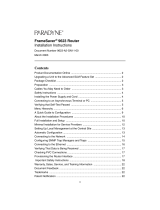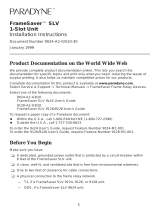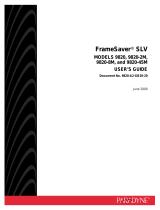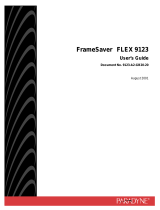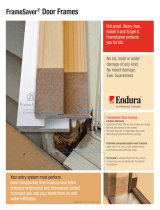
1
FrameSaver
®
SLV 9626
Installation Instructions
Document Number 9626-A2-GN10-40
January 2003
Contents
Product Documentation Online ..................................................................... 2
Upgrading a Unit to the SLM Feature Set ..................................................... 2
Package Checklist ......................................................................................... 2
Preparation ................................................................................................... 3
Cables You May Need to Order .................................................................... 3
Safety Instructions ........................................................................................ 3
Installing the Power Supply and Cord ........................................................... 4
Connecting the COM Port to an Asynchronous Terminal ............................. 5
Verifying that Self-Test Passed ..................................................................... 5
Menu Hierarchy ............................................................................................. 6
A Quick Guide to Configuration .................................................................... 9
About the Installation Procedures ................................................................. 10
Full Installation and Setup ............................................................................ 10
Minimal Installation for Service Providers ..................................................... 13
Setting Up Local Management at the Central Site ........................................ 15
Automatic Configuration ................................................................................ 15
Setting Up the Modem .................................................................................. 16
Setting Up the ISDN DBM ............................................................................ 18
Configuring SNMP Trap Managers and Trap Dial-Out .................................. 21
Connecting to the Network ........................................................................... 22
Verifying the End-to-End Path ....................................................................... 23
Connecting to the DTE (Router or FRAD) .................................................... 24
Connecting the Modem ................................................................................. 25
Connecting to ISDN ...................................................................................... 26
Verifying That Data is Being Received .......................................................... 27
Checking PVC Connections .......................................................................... 27
Verifying That Data Can Be Passed Between DBMs .................................... 28
Connecting the COM Port to the Router ....................................................... 28
Important Safety Instructions ........................................................................ 29
EMI Notices .................................................................................................. 30
Government Requirements ........................................................................... 31
Warranty, Sales, Service, and Training Information ...................................... 34
Document Feedback ..................................................................................... 34
Trademarks ................................................................................................... 34
Patent Notification ......................................................................................... 34

2
Product Documentation Online
Complete documentation for this product is available at www.paradyne.com.
Select
Support Technical Manuals FrameSaver Frame Relay Devices.
Select the following documents:
FrameSaver SLV Technical Description
(9000-A2-GB30)
FrameSaver SLV Configuration Reference
(9000-A2-GB31)
FrameSaver SLV SNMP Reference
(9000-A2-GB32)
FrameSaver SLV Operations Guide
(9000-A2-GB33)
To order a paper copy of a Paradyne document, or to speak with a sales representative,
please call 1-727-530-2000.
Upgrading a Unit to the SLM Feature Set
Full Service Level Management (SLM) capability can be activated in units that have the
basic diagnostic feature set at any time. This is an optional feature that adds real-time
and historical network performance monitoring and SLA (Service Level Agreement)
reporting capabilities to your FrameSaver unit and network. Simply order a Feature
Activation Certificate and provide the model to be activated, your OpenLane
®
SLM
system license key number, and the number of FrameSaver units to be activated to SLM
capability. You can order the certificate for a single unit or for many units.
OpenLane SLM Release 5.3 or above is required to schedule activation of SLM features
in units, and to manage the number of activations remaining on the certificate.
OpenLane also provides a Certificate Summary Report to assist you in the management
of the certificate.
When the Feature Activation Certificate arrives, add the Activation Certificate Number to
your OpenLane SLM application’s database. Activations can occur at any time, for as
many units as desired, until no activations remain for the certificate. When ready to
activate units, simply select the units to be activated and schedule the activations. The
activations occur when scheduled, and OpenLane updates the certificate information.
Contact your sales representative for additional information.
Package Checklist
Verify that your package contains the following:
❑ FrameSaver SLV (service level verifier) unit
❑ Power cord with a desktop 120 VAC power transformer
❑ RJ48S modular cable for U.S. network access
❑ RJ49C cable for ISDN DBM interface
Be sure to register your warranty at www.paradyne.com/warranty.

3
Preparation
Make sure you have:
❑ A dedicated, grounded power outlet that is protected by a circuit breaker within
6 feet of the FrameSaver SLV unit
❑ A clean, well-lit, and ventilated site that is free from environmental extremes
❑ One-to-two feet of clearance for cable connections
❑ A physical connection to the frame relay DDS network
❑ An asynchronous terminal or PC (personal computer).
❑ Configuration information for the FrameSaver unit being installed or replaced.
❑ Appropriate cables:
— Data port cable
— COM port-to-terminal or COM port-to-PC cable
— An RJ11 modem cable
See the appropriate manual for additional information.
For troubleshooting, see the
FrameSaver SLV Operations Guide
For technical specifications, and connectors, cables, and pin assignments, see the
FrameSaver SLV Technical Description
Cables You May Need to Order
Contact your sales representative to order cables.
Safety Instructions
Please refer to the
Important Safety Instructions
on page 29.
If connecting to a . . . Order a . . .
Model/Feature
Number
LAN Customer converter with a DB25 plug on
one end and an 8-pin modular jack on
the other end, with a custom 8-conductor
cable and LAN adapter
3100-F2-910

4
Installing the Power Supply and Cord
Procedure
1. Insert the 4-prong plug into the POWER jack.
When inserting the plug at the rear of the FrameSaver unit, align the plug with the
notch above the POWER jack. Make sure the locking tab snaps securely into the
jack.
4. Plug the power cord into the grounded power outlet.
If any LEDs light, you have power. If not, refer to
Troubleshooting
in the
FrameSaver SLV Operations Guide
for possible explanations.
POWER
COM
DBMMDM
NET
00-16478-01
Power Cord /
Transformer
Insert the 3-prong plug
into an AC outlet.
OK
ALM
The front panel
OK LED lights.
2.
3.
3-Prong
Grounded
AC Outlet
Locking
Tab
POWER

5
Connecting the COM Port to an Asynchronous Terminal
A VT100-compatible asynchronous terminal or a PC providing VT100 terminal
emulation must be used to set up access to and management of the unit.
Procedure
1. Configure the terminal or PC to be compatible with the FrameSaver unit:
— COM Port in use by your PC: COM1 or COM2.
— COM Port Baud Rate set to 19.2 Kbps.
— Character length set to 8 data bits.
— Parity set to none.
— Stop bit set to 1.
— Flow Control set to None.
2. Insert the DB25 end of the EIA-232 cable into the FrameSaver unit’s COM port.
3. Insert the other end of the cable into the terminal or PC.
4. Tighten the screws on each side of the connector to secure them.
5. Press Enter on the keyboard to display the Main Menu.
If the Main Menu does not appear, recheck the terminal or PC settings (see Step 1),
or press the Enter key. Refer to
Troubleshooting
in the
FrameSaver SLV Operations
Guide
for other possible explanations.
Verifying that Self-Test Passed
To verify that the unit passed its self-test, go to the System and Test Status screen.
Main Menu Status System and Test Status
The results of the self-test appears directly under the screen title.
If any failure messages appear, reset the unit by disconnecting, then reconnecting the
power cord. The unit will perform the self-test again. If the failure reappears, call your
service representative for assistance.
POWER
COM
DBMMDM
NET
To Connect to a PC
or Async Terminal
COM
Port
99-16348

6
Menu Hierarchy
The Menu Hierarchy shows the organization of the FrameSaver unit’s screens.
S t at u s
System and Test
Status
Self-Test Results
Last System Reset
Health and Status
Tes t St a t u s
LMI Reported
DLCIs
DLCI
Status
CIR (bps)
IP Path
Connection Status
Device Name
IP Address
Status
Discovery Source
PVC Connection
Status
Source Link, DLCI, EDLCI
Primary Destination Status
Alternate Destination Status
Network Interface
Status
Operating Rate
Loop Loss
DBM Interface
Status
Line Status
Link
Link Operating Mode
Call Status
Most Recent Cause Value
Previous Cause Value
Maximum Link Rate
Negotiated Rate
ISDN Channel
Remote Call ID
I P R o u t i n g T a b l e Destination
Mask
Gateway
Hop
Typ e
Interface
TTL
Performance
Statistics
Service Level Verification
DLCI
Frame Relay
DDS Line
DBM Call
Clear All Statistics
Tr a p E v e n t L o g Number of Trap Events
Time of Day
Event

7
Status
continued
Display LEDs and
Control Leads
I d e n t i t y System
NAM
Test
Network PVC Tests PVC Loopback
Send Pattern
Monitor Pattern
Connectivity
Data Port PVC
Tests
PVC Loopback
Send Pattern
Monitor Pattern
Network Physical
Tests
Local CSU Loopback
Local DSU Loopback
Send Pattern
Monitor Pattern
Data Port Physical
Tests
DTE Loopback
IP Ping
Lamp Test
Abort All Tests
Configuration
System Frame Relay and LMI
PPP
Class of Service Definitions
Service Level Verification
General
Network Physical
Frame Relay
PPP
DLCI Records
Data Ports Physical
Frame Relay
PPP
DLCI Records
PVC Connection
Table
Source Link, DLCI, EDLCI
Primary Destination Link, DLCI, EDLCI
Alternate Destination Link, DLCI, EDLCI
IP Path List Add and Display Static Paths
Management and
Communication
Options
Node IP
Management PVCs
General SNMP Management
Telnet and FTP Sessions
SNMP NMS Security
SNMP Traps
Communication Port
Modem Port

8
Configuration
continued
Auto Backup
Criteria
Auto Backup
DLCI Down Backup Activation Delay
DLCI Down Backup Activation
Transition Threshold
Backup Restoration Delay
When Auto Backup Allowed
Auto-
Configuration
Frame Relay Discovery Mode
Automatic Circuit Removal
Automatic Backup Configuration
Control
Modem Call
Directories
Directory Number
Directory Phone Number
System
Information
Device Name
System Name, Location, Contact
Date
Time
Administer Logins Login ID
Password
Access Level
Change Operating
Mode
Back-to-Back Mode
Standard Mode
Select Software
Release
Current Release
Alternate Release
Switch & Reset
LMI Packet
Capture Utility
Capture Interface
Packet Capture Start/Stop
Status
Packets in Buffer
Display LMI Trace Log
Reset Device
Easy Install
Service Type
Node IP Address
Node Subnet Mask
TS Access
Create Dedicated Network Mgmt Link
Ethernet Management Options Screen
DDS Line Rate

9
A Quick Guide to Configuration
The FrameSaver unit should operate using the default (factory-set) configuration
options, with exception to the changes specified in these installation instructions. Refer
to the following table for help in navigating the menus.
As an example, follow these steps to go to the Configuration Edit/Display menu so you
can start setting up the unit.
To load a configuration for editing:
1. From the Main Menu, press the down arrow key twice so the cursor is on
Configuration.
2. Press Enter to display the Configuration menu. The Load Configuration From menu
appears.
3. Press Enter to select Current Configuration (the cursor is already on this selection).
The Configuration Edit/Display menu appears.
This sequence of steps would be shown as the menu selection sequence:
Main Menu Configuration
To save a configuration option change:
1. Press Ctrl-a to switch to the function keys area at the bottom of the screen.
2. Typ e s or S (Save) and press Enter. The Save Configuration To menu appears.
3. Press Enter again to save your changes to the Current Configuration.
4. Press Esc until the Configuration Edit/Display menu reappears to continue
configuring the unit.
Press Ctrl-a, type m (M
ainMenu), and press Enter to return to the Main Menu.
In the sections that follow, only the minimum option changes required are included so
you will have a quick and trouble-free installation. See the configuration option tables in
the
FrameSaver SLV Configuration Reference
for more information.
Press the . . . To . . .
Esc key Go back one screen or menu level. To see a visual
representation of the menu levels, see
Menu Hierarchy
on
page 6.
Tab key, or
Up ( ), Down ( ),
Left ( ) and Right ( )
Arrow keys
Move the cursor from one menu item to the next.
Enter or Return key Complete the menu or option selection.
Spacebar Display the next available setting when changing a
configuration option. All the available settings for an option
appears at the bottom of the screen.

10
About the Installation Procedures
There are two methods for installing and setting up the FrameSaver unit.
One person can install and set up the unit. If this is the case, see
Full Installation
and Setup
.
An installer can physically install and set up access to the unit, and the network
operation center (NOC) can complete the setup. If this is the case, see
Minimal
Installation for Service Providers
on page 13.
Certain procedures are common to both the full installation and minimal methods. These
procedures (starting with
Setting Up Local Management at the Central Site
on page 15)
are referenced in the full and minimal installation instructions. Refer to them, as needed.
Full Installation and Setup
An Easy Install screen is provided to simplify installation and setup. The Easy Install
feature can be used for the first part of the installation when one person is installing and
setting up the unit from beginning to end.
Easy Install Screen Example
main/easy_install 9626
Device Name: Node A 12/26/2002 23:32
EASY INSTALL
Service Type Frame Relay
Node IP Address: 000.000.000.000 Clear
Node Subnet Mask: 000.000.000.000 Clear
TS Access: DLCI 980
Create a Dedicated Network Management Link
Network1 DDS Line Rate (Kbps): Initialize From Network
Network Initiated DCLB: V.54 & ANSI
DSU Latching Loopback (64CC): Enable
Require DSU Latching Loopback Preamble Enable
---------------------------------------------------------------------------
Ctrl-a to access these functions, ESC for previous menu MainMenu Exit
Save

11
It is assumed that frame relay service is turned on at the site.
Procedure
1. Select the Easy Install feature.
Main Menu Easy Install
2. Enter the Node IP Address and Subnet Mask.
3. Set TS Access to DLCI, then select a DLCI on the network interface that will be
used for the troubleshooting access link.
4. Create a Dedicated Network Management Link, selecting a DLCI for the
management link at the Which DLCI would you like to Create a
Dedicated Network Management Link on? prompt, which will be used by
the NOC to access the unit.
5. Configure the T1 network interface options to match the service provider’s settings.
6. Save the configurations.
7. Install the network cable (see
Connecting to the Network
on page 22). The
FrameSaver unit starts discovering DLCIs and network time slots (see
Automatic
Configuration
on page 15).
The remaining steps are optional, depending upon the application. They are performed
from the Main Menu.
8. If the unit will be enforcing CIR (Committed Information Rate) and EIR (Excess
Information Rate) on network frame relay links, enable Traffic Policing.
Main Menu Configuration Network Frame Relay
You can change other Frame Relay and LMI default settings, if necessary.
9. Configure each interface according to the local management interface (LMI) and
assigned line conditions supplied by the service provider.
Configuration Network Frame Relay
Configuration
Data Ports Frame Relay
10. Set up SNMP local management (see
Setting Up Local Management at the Central
Site
on page 15).
11. Set up the modem, and the Call Directories if trap dial-out is desired (see
Setting
Up the Modem
on page 16).
12. If the unit has ISDN backup capability, set up the DBM (see
Setting Up the ISDN
DBM
on page 18).
13. If SNMP traps are wanted, set up managers, select the desired traps, and configure
trap dial-out if desired (see
Configuring SNMP Trap Managers and Trap Dial-Out
on
page 21).
14. Save the configurations.
15. Verify the entire path from the remote unit to the NMS is functioning (see
Verifying
the End-to-End Path
on page 23).

12
16. Install the DTE cable (see
Connecting to the DTE (Router or FRAD)
on page 24).
17. Install the modem cable (see
Connecting the Modem
on page 25).
18. If the unit has ISDN backup capability, install the ISDN DBM cable (see
Connecting
to ISDN
on page 26).
19. Verify that data is being received (see
Verifying That Data is Being Received
on
page 27).
20. Verify that all PVCs, including Management PVCs, are configured; and see whether
the PVC is active or not (see
Checking PVC Connections
on page 27).
21. Verify the setup for backup, if applicable (see
Verifying That Data Can Be Passed
Between DBMs
on page 28).
The FrameSaver installation is complete.

13
Minimal Installation for Service Providers
In this set of procedures, once the unit is installed and minimal configuration is
completed using the Easy Install feature, the NOC can complete and verify the setup.
Physically Installing the Unit and Setting Up for Remote Access
It is assumed that frame relay service is turned on at the site.
Procedure
1. Follow Steps 1 through 7 of
Full Installation and Setup
on page 10.
2. Install the DTE cable (see
Connecting to the DTE (Router or FRAD)
on page 24).
3. Install the modem cable (see
Connecting the Modem
on page 25).
4. If the unit has ISDN backup capability, install the ISDN DBM cable (see
Connecting
to ISDN
on page 26).
Physical installation of the unit is complete; the NOC can now remotely access the unit
for additional configuration.

14
Completing Setup of the Unit From the NOC
Procedure
1. Access the remote FrameSaver unit using the dedicated management link, using
the Node IP Address that was entered (see
Physically Installing the Unit and
Setting Up for Remote Access
on page 13).
2. Configure specific frame relay options, like CIR (committed information rate), and
any other configuration options requiring input or changes from the default settings.
3. Configure each interface according to the local management interface (LMI) and
assigned line conditions supplied by the service provider.
Configuration Network Frame Relay
Configuration Data Ports Frame Relay
4. If SNMP traps are wanted, set up managers, select the desired traps, and configure
trap dial-out if desired (see
Configuring SNMP Trap Managers and Trap Dial-Out
on
page 21).
5. Set up the modem, and the Call Directories if trap dial-out is desired (see
Setting
Up the Modem
on page 16).
6. If the unit has ISDN backup capability set up the DBM (see
Setting Up the ISDN
DBM
on page 18).
7. S
ave the configurations.
8. Verify the entire path from the remote unit to the NOC NMS is functioning (see
Verifying the End-to-End Path
on page 23).
9. Verify that data is being received (see
Verifying That Data is Being Received
on
page 27).
10. Verify that all PVCs, including Management PVCs, are configured; and see whether
the PVC is active or not (see
Checking PVC Connections
on page 27).
11. Verify the setup for backup, if applicable (see
Verifying That Data Can Be Passed
Between DBMs
on page 28).
The FrameSaver installation is complete.

15
Setting Up Local Management at the Central Site
Procedure
1. Create a DLCI for the data port.
Configuration Data Ports DLCI Records
2. Save the configuration.
3. Create a Management PVC using the data port DLCI just created.
Configuration Management and Communication Management PVC
Minimally, enter the following options:
— Name for the management PVC
— Interface IP Address and Subnet Mask, if different from the Node’s
— Primary Link for this Management PVC (the user data port)
— Primary DLCI (i.e., the data port DLCI)
4. S
ave the configuration.
Automatic Configuration
The FrameSaver unit provides several automatic configuration features. Frame Relay
Discovery and configuration is one of these features.
Main Menu Auto-Configuration
The default discovery mode is 1MPort. In this mode, for each DLCI discovered on the
network, the unit creates a network interface DLCI containing two EDLCIs (embedded
DLCIs – one for Port-1 data and the other for management), a Port-1 DLCI with the
same number, and a management PVC, then cross-connects them.
NOTE:
When auto-configuration creates a multiplexed DLCI, but a standard DLCI is
needed, change the DLCI to Standard from the network DLCI Records screen:
Configuration Network DLCI Records
Other modes can be selected. See
Setting Up Automatic Configuration
in the
FrameSaver SLV Configuration Reference
for information about other modes and how
the Frame Relay Discovery Mode can be changed.
No automatic configuration occurs until the network cable is connected. If you do not
want management links configured or automatic configuration, change the default
setting for the Frame Relay Discovery feature.

16
Setting Up the Modem
The unit has an integral modem for remote management. It is already set up for dial-in
access to the system, with Port Use set to Terminal.
Procedure
If using the modem for dialed IP network connectivity (SNMP, Telnet, FTP, or trap
dial-out):
1. Select Modem Port.
Configuration Management and Communication Modem Port
2. Minimally, change Port Use to Net Link, and assign the interface’s IP Address and
Subnet Mask if it is different from the Node’s. Change Link Protocol to SLIP, if
necessary (PPP is the default setting).
3. S
ave the configuration.
Setting Up Call Directories if Trap Dial-Out Is Desired
Procedure
1. Set up directory phone numbers.
Main Menu Control Modem Call Directories
2. Select Directory Number A (for Alarm).
3. Enter the phone number(s). Valid characters include:
— ASCII text
— B for blind dialing
— W for wait for dial tone
— P for pulse dialing unless B specified
— T for tone dialing unless B specified
— Space, underscore ( _ ), comma (,) for a 2-second pause, and dash (–)
readability characters
4. S
ave the phone number(s).

17
Setting Up to Use the Modem PassThru Feature
The Modem PassThru feature allows access to the router via a dial-up connection to the
unit. When this feature is set up and active, a logical connection between the unit’s
modem and COM ports is made, and data received over the modem port is transmitted
out the COM port to the router’s auxiliary (AUX) serial port. When an escape sequence
(minus, minus, minus) is detected, the FrameSaver unit switches back to normal user
interface operation. If this feature will be used, the COM port must be configured for that
use.
Procedure
1. Configure the COM port to use Modem PassThru.
Main Menu Configuration Management and Communication
Communication Port
2. Set Port Use to Modem PassThru.
3. Save the configuration.

18
Setting Up the ISDN DBM
These instructions are for units with ISDN backup capability. The ISDN BRI DBM
supports up to 2 B-channels.
The following guidelines apply:
Central site configuration guidelines:
— Set up the ISDN DBM physical interface.
— Change the Automatic Backup Configuration to Multi_Site_Backup. (A BRI
DBM is configured for Single_Site_Backup.)
— Modify the Link Profile(s) that Automatic Backup Configuration created to add a
phone number.
Remote site configuration guidelines:
— Set up the ISDN DBM physical interface.
— Modify the HQ_Site Link Profile that Automatic Backup Configuration created
to add a phone number.
— Set the criteria by which automatic backup will take place.
Setting Up the DBM Physical Interface
Procedure
1. Configure the DBM interface.
Main Menu Configuration ISDN Physical
2. Minimally, set the following configuration options:
— Interface Status set to Enable.
— Service Profile ID1 (SPID)
— Local Phone Number 1
— Service Profile ID2 (SPID)
— Local Phone Number 2
3. S
ave the configuration and return to the ISDN menu.

19
Setting Up Automatic Backup Configuration
The Automatic Backup Configuration feature, included on the Auto-Configuration menu,
is used to automatically create alternate DLCI records and PVC connections on the
ISDN DBM (backup) interface.
This feature is already set up in FrameSaver units with a DBM. Single_Site_Backup is
the default for a BRI DBM.
See the
FrameSaver SLV Configuration Reference
for additional information.
Modifying ISDN Link Profiles
Procedure
1. Select Link Profiles, then Modify.
2. Add a name and phone number to the ISDN Link Profile(s) created by Automatic
Backup Configuration.
— Name for the destination entered (e.g., Tampa). The default setting is HQ_Site.
— Phone numbers entered:
NOTES:
Remember to include local dial-out numbers (i.e., 9, then the number).
For every originating (outbound) phone number entered, an answering
(inbound) phone number must be entered at the far end, and vice versa.
— Maximum Link Rate is changed, if necessary. The default setting is 64 Kbps.
3. S
ave the configuration.
For Originating a Backup Call For Answering a Backup Call
Outbound and Alternate Outbound phone
numbers
Valid characters can include:
Numbers (0–9)
Special characters * and #
Spaces
Parentheses ( )
Inbound Calling ID1 and ID2
These are the phone numbers of
units from which calls will be
accepted.
Valid characters can include:
Numbers (0–9)

20
Setting the Criteria for Automatic Backup
Procedure
1. Enable Auto Backup.
Main Menu Configuration Auto Backup Criteria
When a failure occurs, the unit automatically enables the Alternate Link and traffic
is rerouted over the backup (alternate) interface.
2. Specify When Auto Backup Allowed – Always or Restrict. If Restrict is selected,
specify the days and hours of the week during which automatic backup can take
place.
3. S
ave the configuration.
Page is loading ...
Page is loading ...
Page is loading ...
Page is loading ...
Page is loading ...
Page is loading ...
Page is loading ...
Page is loading ...
Page is loading ...
Page is loading ...
Page is loading ...
Page is loading ...
Page is loading ...
Page is loading ...
Page is loading ...
Page is loading ...
/
